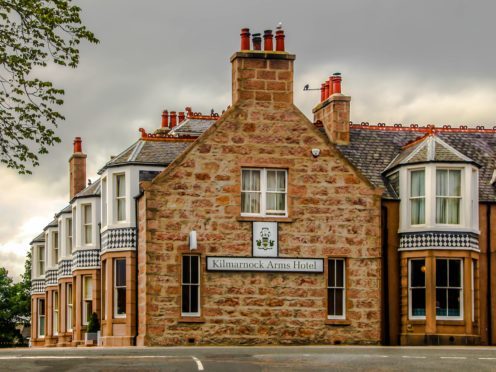The hotel where Bram Stoker began writing Dracula is to be recognised with a special plaque celebrating the link.
Mr Stoker first discovered Cruden Bay, then known as Port Erroll, on a walking holiday to Aberdeenshire in 1893.
He returned in 1894, booking into the Kilmarnock Arms Hotel and writing in the guest book: “Second visit to Port Erroll. Delighted with everything & everybody & hope to come again to the Kilmarnock Arms.”
The following year he checked in again to write the early chapters of Dracula and returned to Aberdeenshire in 1896 to complete the later chapters, though it is not known if he stayed in Cruden Bay on that visit.
Nearby New Slains Castle, with its dramatic cliff-top location, is believed to have acted as a “visual palette”, inspiring some of the scenes in the book.
The listed castle contains a room that has a look-alike in the novel – the octagonal hall used as a reception room for visitors.

Mike Shepherd, a member of the Port Erroll Heritage Group, nominated Stoker for a plaque to bring attention to the Kilmarnock Arms Hotel’s role in the early days of the novel’s creation.
He said: “Bram’s special place is our special place. The new plaque is the first-ever celebration of the link between Bram Stoker and Cruden Bay.
“As such, it will provide a focus for that pride.”
Born near Dublin in 1847, Bram Stoker was a part-time writer for most of his life.
Later in his career, for 11 months out of every year, he worked as the business manager at the Lyceum Theatre in London and as the personal manager for the famous English stage actor Henry Irving.
After 1894 he spent the other month on holiday in Cruden Bay where he wrote his books.
Mr Shepherd said: “Bram Stoker knew everyone in elite society but instead of going on holiday to a continental spa or grouse shooting like his peer group he would go to a fishing village on the Aberdeenshire coast year after year, it took him more than 14 hours to get there.
“I think Cruden Bay was his very special place where he could feel at one with nature and he had the peace and quiet to write his books, and that’s probably why he returned year after year.”

Historic Environment Scotland’s Commemorative Plaque Scheme celebrates the lives of significant people by erecting plaques on the buildings where they lived or worked.
Stoker’s plaque is the 57th announced under the scheme since it began in 2012 and will be unveiled in the new few months.
Caroline Clark, Historic Environment Scotland grants operations manager, said: “Bram Stoker’s plaque is one of several awarded over the past six years to writers, poets and artists who have drawn inspiration from Scotland’s architectural history and natural heritage to create their works.
“The beauty of our Commemorative Plaque Scheme is that it highlights notable historic figures who we might never have known had deep connections to Scotland.”
The remaining 13 successful plaque nominations under the 2018 Commemorative Plaque Scheme will be announced over the coming months.
Mr Shepherd is the author of the new book, When Brave Men Shudder: The Scottish Origins of Dracula, which looks closely at Bram Stoker’s links to Scotland and Cruden Bay and will be published on October 31.









